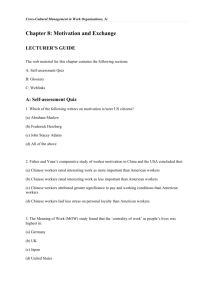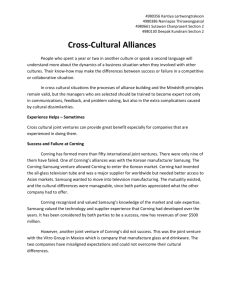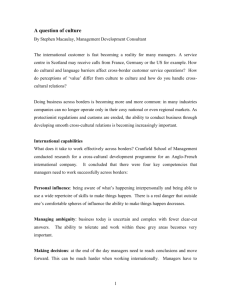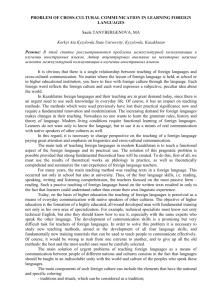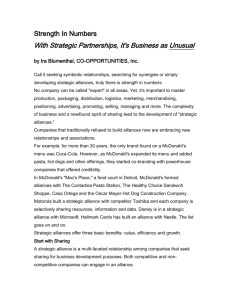Cross-Cultural_Allia..
advertisement
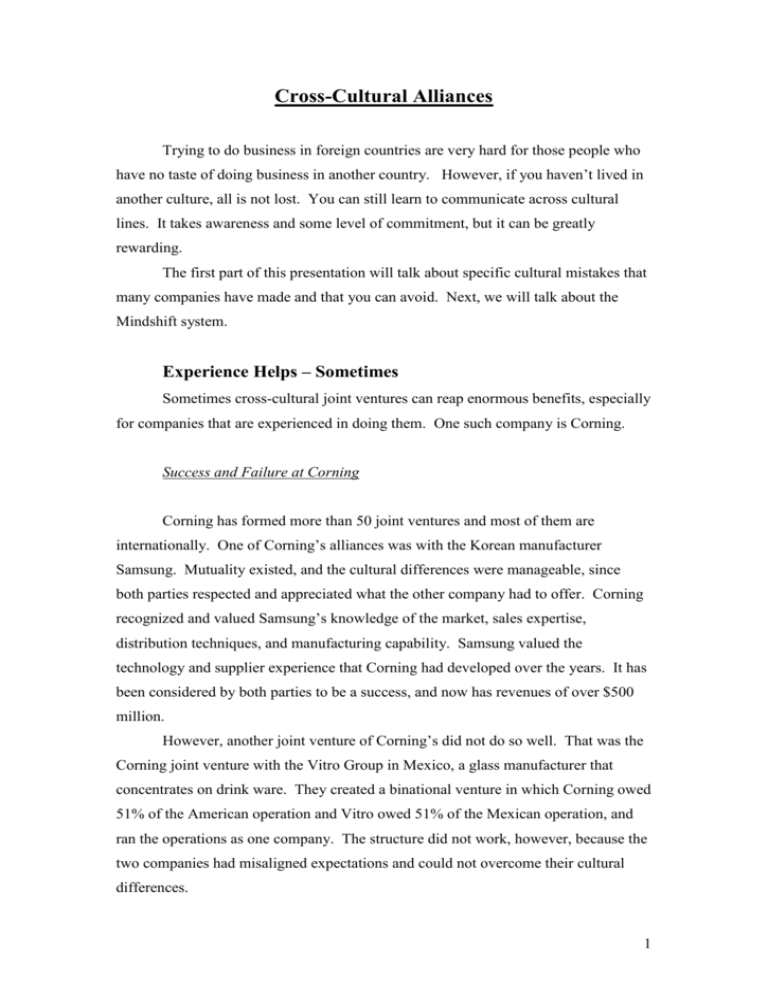
Cross-Cultural Alliances Trying to do business in foreign countries are very hard for those people who have no taste of doing business in another country. However, if you haven’t lived in another culture, all is not lost. You can still learn to communicate across cultural lines. It takes awareness and some level of commitment, but it can be greatly rewarding. The first part of this presentation will talk about specific cultural mistakes that many companies have made and that you can avoid. Next, we will talk about the Mindshift system. Experience Helps – Sometimes Sometimes cross-cultural joint ventures can reap enormous benefits, especially for companies that are experienced in doing them. One such company is Corning. Success and Failure at Corning Corning has formed more than 50 joint ventures and most of them are internationally. One of Corning’s alliances was with the Korean manufacturer Samsung. Mutuality existed, and the cultural differences were manageable, since both parties respected and appreciated what the other company had to offer. Corning recognized and valued Samsung’s knowledge of the market, sales expertise, distribution techniques, and manufacturing capability. Samsung valued the technology and supplier experience that Corning had developed over the years. It has been considered by both parties to be a success, and now has revenues of over $500 million. However, another joint venture of Corning’s did not do so well. That was the Corning joint venture with the Vitro Group in Mexico, a glass manufacturer that concentrates on drink ware. They created a binational venture in which Corning owed 51% of the American operation and Vitro owed 51% of the Mexican operation, and ran the operations as one company. The structure did not work, however, because the two companies had misaligned expectations and could not overcome their cultural differences. 1 An example of a successful intercultural collaboration on a grand scale An example is the four-nation Airbus project. The partners were Britain, Spain, West Germany, and France, and each group had its responsibilities well defined, with mutually negotiated milestones for each team to achieve. The management of the project was decentralized so that decision making was on the local level. This short-circuited lengthy debates and possibilities for misunderstandings. However, despite the great differences in style, philosophy, and language among the Airbus team members, collaboration and a desire to do a job well overcame the intercultural issues that could at many points have tom the project asunder. Unlike Americans, Europeans generally are used to working closely with people from other cultures, and here the country differences became issues the team members were determined to overcome, since the venture was one of great strategic and economic importance to all concerned. Airbus’s powerful aircraft market is evidence of the success of the venture. Another variable that must be taken into account by those looking to develop cross-cultural alliances is the fact that there are subcultures within many country cultures. Consequently, it’s important to verify whether the cultural assumptions that you are making are valid for the specifics of your alliance issues, or whether they have been modified by particular subcultural characteristics. For example, the degree of formality is an element of a country’s culture, but in the United States it differs greatly among subcultures. Acceptable dress in southern California, where the relaxed style is preferred, may be unacceptable in Chicago or New York. Cross-Cultural Learning Exchanges A benefit that is often undervalued in cross-cultural alliances is the transfer of techniques that work in a non-U.S. - based alliance back to this country’s operations. Senior management often expresses a desire for 2-way learning, but workers who are on the front lines operation can see successful practices in foreign operations of the same company as a threat to their job security. 2 Motorola Management in Malaysia Motorola’s plant in Penang, Malaysia, is regarded as the best in productivity, quality, and innovation in the company’s Land Mobile Division. Their qualitycontrol program relies in the part on thousands of recommendations from employees. By doing so, employees were motivated by the feeling of belonging to an important endeavor, of being a family of workers who would all benefit from productivity and process improvement. However, this method is not successful in the United States. To be effective, management techniques must be accultured. In Malaysia, some successful approaches were creation of a group incentive and of a sense of family among the workers. But this approaches needed to be modified for the US culture since American workers required more than praise and group accolades. Some plants have instituted cash rewards as incentives for individuals. A common issue for workers in both areas is the fear of losing jobs. So management needed to make it clear that they desired the US. Group to develop a team approach and to modify a cultural preference for individual gain. As you can see the Malaysian approach ultimately reaped benefits in the US—but only after cultural norms had been taken into account. The Cross-Cultural Interpreter One effective tool for managing the unique challenges of such alliances is the cross cultural interpreter. It doesn’t mean a language interpreter, but someone who either comes from or has lived at length in both your and the partner’s cultures and will understand the nuances of verbal and nonverbal communication and perception in both cultures. Understanding value across cultures It’s difficult for an organization to compete in the global arena without international partners and alliances. This is not only because of the need to defray immense fixed costs, but also in order to truly understand cultural perceptions of value. The strategy of selecting the right partner is also important in developed 3 countries where chances of failure are exacerbated because of cultural miscommunications. It is important when attempting to understand the political culture of an organization or a country that we look at the characteristics that are critical for success abroad or in a cross-cultural alliance. Many times, acceptable profits in one country are unacceptable for another country. An example is the U.S.A and Japan. Japanese do not require the same level of profits as American firms. It is also important to asses the situation; is it beneficial for our organization to remain in our protected environment? Is this the best way for us to compete? It is possible to implement certain strategies that will help your organization succeed abroad. Such strategies are arranging for a local management team to undertake the operation with the supervision of the parent company. In this situation, the management team must be fluent in English as to not create any communication barriers or mistakes. Now we can look at four elements of Country Culture: 1) Power Distance: extent that culture accepts power hierarchy in organiazation 2) Uncertainty Avoidance: extent that corporate culture is afraid of uncertainty 3) Individualism/Collectivism: common thought of in-groups and the right people 4) Masculinity/Femininity: male-dominated, female-dominated, acceptance? Each culture, whether it be corporate or country, has unique differences and similarities, and it is extremely important for companies to analyze these differences and similarities if they are to begin work in those countries or with those organizations. Choosing the wrong partner can be catastrophic for both parties, as well as choosing a management team that is unfamiliar with local laws, and regulations. 2. Delegating Authority The EMF Foundation Survey looked at the willingness of managers to delegate authority. The willingness shows that managers have sufficient interaction with subordinates, and they are confident in their subordinates’ skills and judgments in the operation of given tasks. The survey shows that Japan has the highest score, 72%, 4 Sweden next, 70%, and the U.S., third, 68%. This national characteristic relates to the life-cycle phase of the organization. For example, characteristics of the Adventurer managers in the start-up company is that they need absolute control, they don’t want delegate power to others because they think they can do it better and faster. This will lead to weak management structure and lack of management depth. 3. Marketing Push and Product Quality This topic shows about the abilities of managers to sell product and how these abilities related to the quality of the product sold. The EMF survey found that the countries with the highest reputation for both market push and high-quality products are Japan, Switzerland, Sweden, and Denmark. The marketing and sales presentation of the U.S. company is not consistent with the promised product quality because the U.S. is ranked as the second in marketing push and fourteenth for product quality. The companies that push the product too hard can cause losing product credibility, especially if the quality of product sold is not as good as is represented. 4. Willingness to Create and Exploit Technological Innovation EMF also tells about the relationship between the stated readiness of corporations to exploit innovation and the average number of patents granted per 100,000 inhabitants of the country. The U.S. has been perceived worldwide as the most innovative culture and the most embracing of novel ideas and technologies. However, the survey shows that Japan is a world leader in technological innovation. Their willingness to exploit such innovation is backed by large amount of capital, low interest government subsidies, and the policy that supports industrial research. The area of technological innovation personality characteristics must be interrelated with national cultural norms. Planning the Cross-Cultural Alliance The key skill of managers involved in building alliance must be the ability to work in ambiguous, unfamiliar, cross-functional, and transcultural relationships. The team must include a cultural interpreter who has a lot of experiences with people in different cultures. He will know what thing is work and what is not in each culture, how to gain buy-in, and whether it is possible to do so. The home country has to 5 recognize the constraints as well as the opportunities in the international markets. Not only integrating local product needs and management attitudes, but also adjusting their own perceptions of time, leadership, and reward into their plan. The omission of these important perspectives increases the failure potential of international alliances. Culture Clash : Making Shoes in China One of the culture-based management differences is American company in China for the manufacture of shoes. It is managed by young and aggressive entrepreneur who believes that his way is not only the best but also the only way to do the business. The Chinese partner in the project is made up of a group of villagers. The cooperative is an interesting mix of contradictions. First, it is a start-up with the insecurities and cultural collectivism. The village and project manager is an adventurer. The decision making is based on consensus. Although it is sound like the equality is a major rule, for the Chinese culture, the older member of the collective will be greatly respected. At some point, problems occur in manufacturing process, and the product that is produced is not good quality. The production is late and the delivery schedules are slipping. It is clear that the managerial style, and the lack of understanding of how business is transacted and decisions are made in China create problems to manager due to the cultural differences. To apply the cultural dynamics of collectivism and femininity, cultural traits of Chinese, the U.S. company might have appreciated that the manager needed time to understand and convey the concepts of value to his team. Therefore, if the manager wants to see a successful business alliance, he has to understand the values and cultures of the partner very well to avoid any problems. The understanding of what it takes to get buy-in to any strategy will require cultural input. For example, in Sweden, a strong commitment or responsibility and sense of identification with the corporate entity is one national cultural characteristic. This is helpful in understanding occasional managerial reluctance to do anything that is not fit directly with the corporate culture. The fluency in English does not change the national characteristics, so the meaning, application, and expectation might cause greater misunderstanding, even though, they communicate in English. 6 Culture Clash: Bringing Swedish Pharmaceuticals to the U.S.A A large U.S pharmaceutical company entered into an alliance with a small Swedish company. Initially, everything does fine; U.S partner approached the project with enthusiasm. Purpose of both companies: Open up their market in a particular area of medical devices and diagnostics. U.S company interest: the technology developed by the Swedish firm Swedish company interest: the experience and knowledge of how to negotiate and succeed in the FDA approval process and want to penetrate the U.S. market and create distribution network to generate sales. Cause of Failure: 1) The U.S. Company does not create a joint implementation plan with the Swedes and independently decides on the composition of the team for the new division and staffing it with scientists and planners. 2) The Swedish Company thinks that the U.S. partner which is large, reputation, and experience in U.S. market know exactly what they are doing. These two points imply: 1) Lack of cross-functional teams containing the talent necessary to achieve the goals of the parties. 2) Misalignment of the partners’ objectives. The sad story continues that U.S. team starts to reengineer the Swedish product and the planners push the FDA application date further out. This caused the Swedes are very frustrated and concerned. Once they indicate their concern about the delays, the U.S. representatives explain that they only present the highest quality products with their imprint and scientific expertise to the FDA. Months went by, the trust destroyed. Once the Swedes called for dissolution of the relationship, the problems can be analyzed both strategically and culturally: 1) The Swedes purpose is low on the Pyramid of Alliances which required less capital, lower risk, and less use of human resources. On the other hand, the U.S. Company sees the alliance as being higher up on the Pyramid of Alliance like R&D which is required higher risk. He parties’ goals are misaligned. Their plans are not jointly developed 2) The Swedish company was a Start-up and their project was Bet the Farm. This means that the willingness to wait for U.S. Company to bring the product to market is limited. In addition, they want to see market entry and revenue 7 increased within a fairly short period of time. In contrast, U.S. Company sees the project as Experimental. They allocate resources, but the wrong ones. HOW THESE MISALIGNMENTS WERE HANDLED HAS TO DO PRIMARILY WITH CULTURAL MISCOMMUNICATION, BOTH CORPORATE AND COUNTRY. 1) Miscommunication from he very beginning o the Mature company. The adventurer mangers might thought that they know what they are doing or look how successful hey have been. The FDA process is complicated and takes time, so best is to wait. 2) Cultural issue: The Swedes part, “We will let them know that we are concerned about the loss of a market window of opportunity”. “We see the stereotype of all U.S> companies as market savvy and also a cultural reluctance o confront” The American part, they see to gain access to Swedish technology as the achievement of their primary goal. Once they had examined and evaluated the technology, obtaining FDA approval was something they intended to do. The result is completely breakdown of the relationship which are no trust, no confidence, and loss of face and opportunity on both sides. Migratory and Embedded Knowledge and Country Culture It is crucial to understand the issue of cultural differences in the way information communicated. Communication is governed by norms, but cross-cultural expectations are different in embedded and migratory knowledge transfer. This is because communication will be interpreted differently according to the rules of each culture. Relationship failures are compounded when you superimpose cultural issues on the fact that companies only value and negotiate for the migratory knowledge transfer. In China-U.S. joint ventures, misunderstanding can be occurred because U.S. partner will state goals clearly, namely and access to the Chinese market. Whereas, the Chinese partner indirectly approaches the relationship and hind its real agenda. Unintended Knowledge Transfer to China 8 Because of the uncertainty of Chinese partner, this causes much dissatisfaction to the U.S. Company. For example, the deliverable deadline date for the project kept changing and this constant redefinition of the partnership goals decrease the U.S. Company’s original enthusiasm for the project. Also, the transfer of embedded knowledge also led to strong feeling of being taken advantage of. For example, Chinese representatives came to visit continuously to the U.S. Company to update information. This cause U.S. partner thinks further that whether they want to continue involving in doing business in China or looking for other emerging countries would be better choice. Finally U.S. partner decided to withdraw all resources from Chinese project and move to India which they could limit the knowledge transfer predominantly to migratory knowledge. 9


